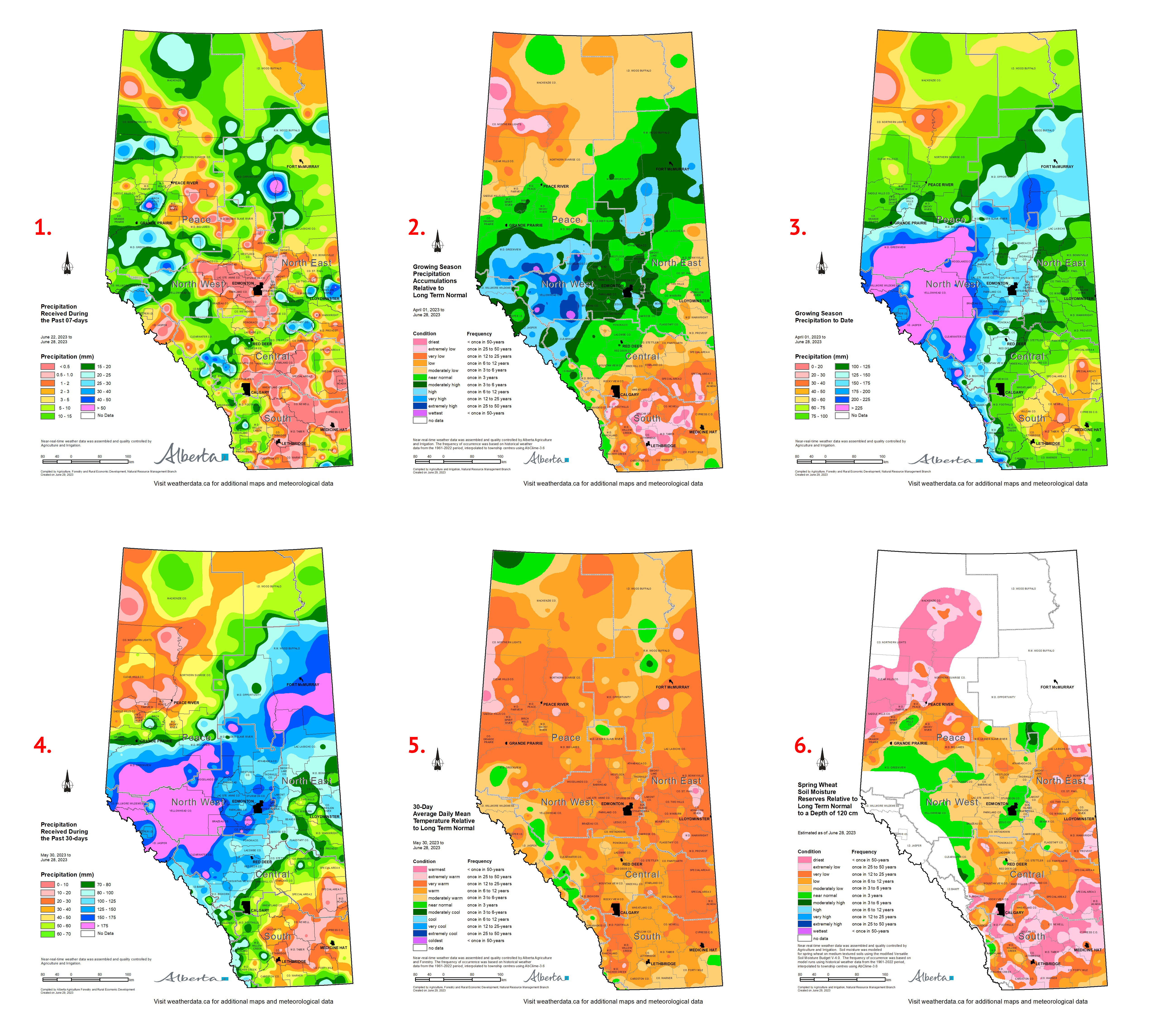Moisture Updates - June 28, 2023
Synopsis
Map 1: During the period from June 13 to June 20, 2023 (covered in the last report) large parts of the province from Calgary to Grande Prairie received much needed rain. Unfortunately, much of the Southern Region, Eastern portions of the Central Region and most of the North‑half of the Peace Region, remained dry. Since that time, province wide, rain has only fallen as a result of wide spread thunderstorm activity. Map 1 shows a veritable patchwork of rainfall accumulations over the past 7-days, suggesting only spotty relief to some of the dry areas, providing you were lucky enough to be in the path of these storms and escaped hail or damaging winds. Significantly much of the persistently dry lands across the Southern Region, Central Region and parts of the northern Peace Region remained dry and absent of wide spread thunderstorms.
Late today (Thursday, June 29, 2023), a low pressure system is set move into the province along the Northwestern border and by Sunday, rainfall is forecast to have fallen across a wide area of the province from roughly Calgary to High Level. It remains to be seen precisely where and how much rain will fall but this may bring some moderate relief to the Northern Peace Region where it’s very much needed now. Southern Alberta and the Eastern half of the Central Region appear to be remaining dry and sporadic thunderstorm activity will likely be the only source of moisture in the near future.
Growing Season Moisture Conditions since May 1, 2023
Maps 2 & 3: Since the start of the growing season (April 1, 2023) about 40% of the agricultural areas have received above average moisture (Map 2). However, for the Southern Peace Region, much of this fell during the May long weekend, and for most other areas during the third week of June. Thus, while the total amount of moisture appears good in these areas, its timing was not ideal, as it was interspersed with long stretches of hot/dry weather, coupled with low soil moisture reserves resulting in various levels of moisture stress. From about Red Deer South and from the town of Peace River North, growing season precipitation deficits have been intensifying with several pockets of once in 50-year lows scattered though the Southern Region and at least once in 12 - 25 year lows prevalent through parts of the Western and Northern portions of the Peace Region.
In the 89-day period this represents, lands around Manning have received less than 50 mm of moisture and lands through parts of the Central and Southern Regions received similar amounts (Map 3). Within these areas some have received less than 30 mm. In comparison average accumulations over this time frame are in the range of 100-120 mm across the Peace Region and 130-150 mm across the Southern Region. Looking forward, on average Southern Alberta typically enters a dryer regime and receives only 30-50 mm during July whereas the Peace Regions receives 75-100 mm.
Precipitation and Temperature Trends over the Past 30-Days
Maps 4 & 5: As the growing season progresses and plants grow larger, water requirements increase and the need for regular moisture intensifies. Over the past 30-days many parts of the Peace Region have received less than 20 mm of rain, along with a large portion of Southern Alberta and parts of the Southeastern portions of the Central Region (Map 4). This lack of moisture has also been accompanied by above average temperatures (Map 5) and crop moisture demands are not being met. Most areas within the yellow category on Map 4 (< 50 mm). have had less than optimal moisture for sustaining good crop growth. However, as Map 1 shows, thunderstorm activity has been wide spread and some areas may have received more moisture than what is depicted, while others nearby have seen less.
Soil Moisture Reserves Relative to Normal as of June 28, 2023
Map 6: Plant water demand is increasing daily and has resulted in a depletion of moisture reserves across much of the Northwest, which in the last report were near normal. Currently, few agricultural areas have near normal moisture reserves (Map 6). Moisture deficits have been intensifying across large parts of the Western and Northern portions of the Peace Region and across much of the Southern and Central Regions. Generally for all areas south of Red Deer and across much of the Eastern-half of the Northeast region and large portions of the Peace Region, soil moisture reserves are drawing down and rain will be needed soon to sustain crop growth.
Contact Us
Saddle Hills
Junction of Hwy 49 & Secondary Hwy 725
RR1, Spirit River AB
T0H 3G0
T. 780-864-3760
Fax 780-864-3904
Toll-free 1-888-864-3760
frontdesk@saddlehills.ab.ca
Sign up to our Newsletter
Stay up to date on the Saddle Hills activities, events, programs and operations by subscribing to our eNewsletters.

